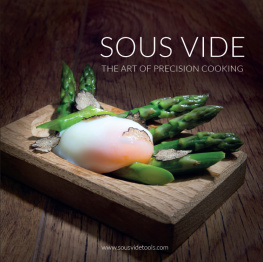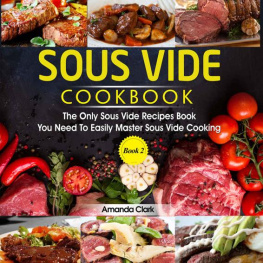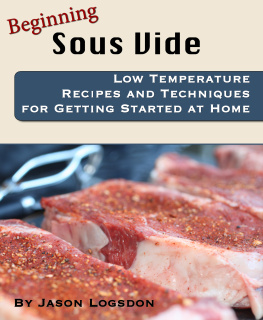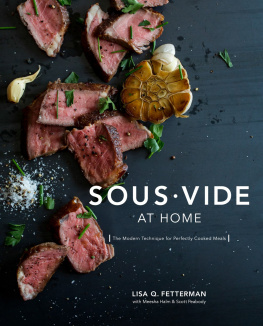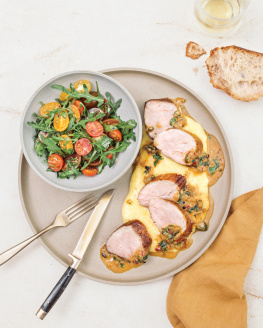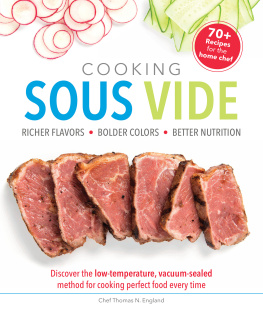With all cooking techniques heat penetrates the outside of the food until the centre gets to the right temperature.
SOUS VIDE vs CONVENTIONAL COOKING METHODS
With all cooking techniques heat penetrates the outside of the food until the centre gets to the right temperature.
If you wanted a rare piece of beef you would cook the centre to 54C. To do this you may roast it in an oven at around 180C. By the time the centre of the beef is at 54C the outside of the beef is way overdone. In fact most of the joint would be well done and grey. But if you roasted it at 54C, none of the meat would get overdone, although it takes so long for the centre to get to the right temperature the meat would dry out. If you stopped roasting too early so it didnt dry out, the centre would still be raw.
With the sous vide technique you cook food at the temperature you want the whole joint to be at. By sealing it in a vacuumed bag, or pouch, none of the meat is overdone or dry, and you keep all the nutrients and flavours.
WHY IS PRECISE TEMPERATURE CONTROL IMPORTANT?
The art of sous vide cooking is finding the perfect core temperature to achieve the desired taste and textures. Think of a dish that features an egg with a creamy, custardlike texture. One chef might cook that egg to a core temperature of 61.7C, while another may prefer cooking it to 63.3C. The finished eggs will be very different from each other.
It makes each chefs dish unique.
THE SCIENCE
When cooking, the heat induces chemical reactions with different effects at different temperatures. For example, the different pro- teins in the albumen of eggs coagulate at specific temperatures. Just a few degrees difference in cooking temperature will affect just how much the egg white solidifies. Temperature affects meat in the same way. Cuts with high collagen content, such as a pork belly, should be cooked for longer and at higher temperatures.
This will break down the tough connective tissue. Meat with little connective tissue, like fillet steak, would get tough if cooked at those temperatures. Just a few degrees can make a difference in an expensive cut of meat.
CAN I NOT JUST USE A PAN OF WATER OR SLOW COOKER?
The right equipment is a vital part of the sous vide technique. Unlike slow cookers or simmering pans of water, sous vide equipment offers precise temperature control along with set it and forget it convenience. Basically you set it to cook food to a precise core temperature, within a fraction of a degree, with just one single adjustment.
Maintaining a slow cooker or pan of simmering water at just the right temperature is practically impossible, and it is much harder for results to be consistent. Also, because they dont circulate the cooking liquid, these methods can develop hot and cool zones that affect the cooking process.
HOW DO COOKING TIMES VARY?
Cooking at low temperatures for long periods of time is what creates the delicious results of sous vide. However, it does take testing and experience to determine the right amount of time needed to cook a dish exactly how the customer wants. The
sousvidetools.com team can help with this. In general, cooking time is affected by three factors:
- The core temperature you wish to cook the dish to,
- The heat transfer characteristics of the food,
- The amount of food that will be cooked at one time.
Food will reach the core temperate quicker with a greater cooking liquid to food ratio.
When cooking sous vide, the pouches must be completely covered with liquid and you should allow enough room for the pouches and liquid to circulate freely. One advantage of sous vide cooking is that its much harder to overcook a dish by leaving it too long. Once a dish reaches the desired temperature, it takes more time to keep cooking the food. This means you can keep it at that temperature for longer without the food shrinking, drying out or becoming tough. This is a great benefit when cooking expensive cuts of meat.
HOW DOES THE SOUS VIDE TECHNIQUE IMPROVE PRESENTATION?
The enjoyment of food is a very personal experience and it must please all our senses.
Weve all had our expectations raised by the sight of a well-presented dish, the aroma from the plate, or the sizzling sound of a hot meat. To complement and enhance the melt in the mouth tenderness, many chefs finish sous vide meat dishes by briefly grilling or pan/ blowtorch searing. It creates a browning reaction and then the familiar aromas and flavours that come with highheat cooking. The main difference with food cooked using the sous vide technique and finished in this way is that the inside remains tender and moist.
HOW TO COOK USING THE SOUS VIDE TECHNIQUE?
The sous vide cooking process is very simple:
- Set the thermal circulator or water bath to the desired cooking temperature,
- Vacuum seal the food,
- Place the vacuum sealed food in the water bath.
The thermal circulator or water bath will maintain the water or oil at the desired temperature.
VACUUM PACKING IS A METHOD OF PACKAGING, STORING, PRESENTING AND THEN COOKING FOOD...
Some food types need to be stored in an airless environment, usually in air-tight packaging to reduce the growth of microorganisms.

